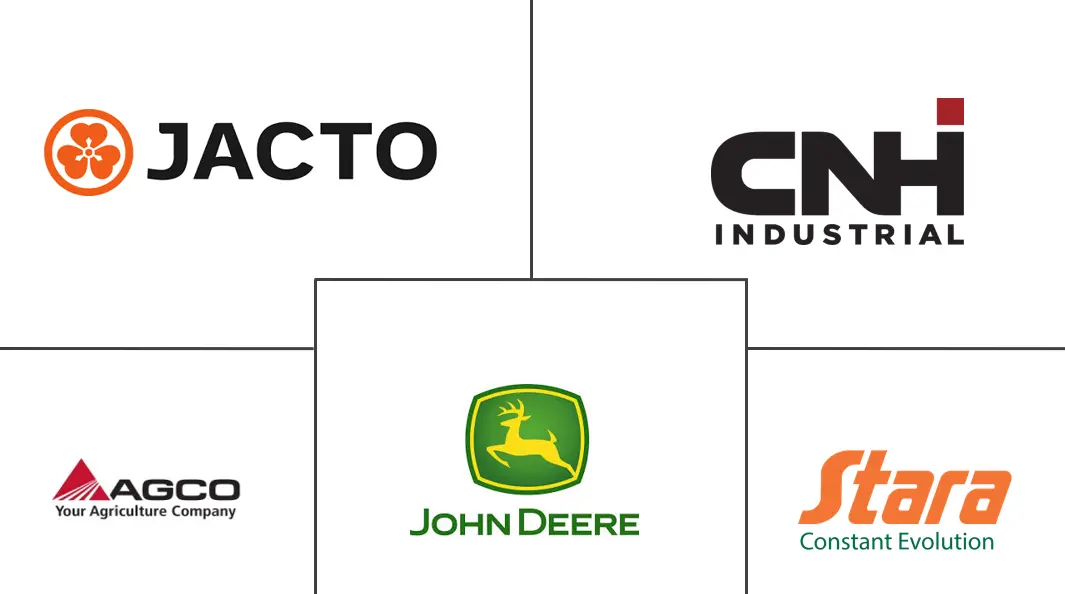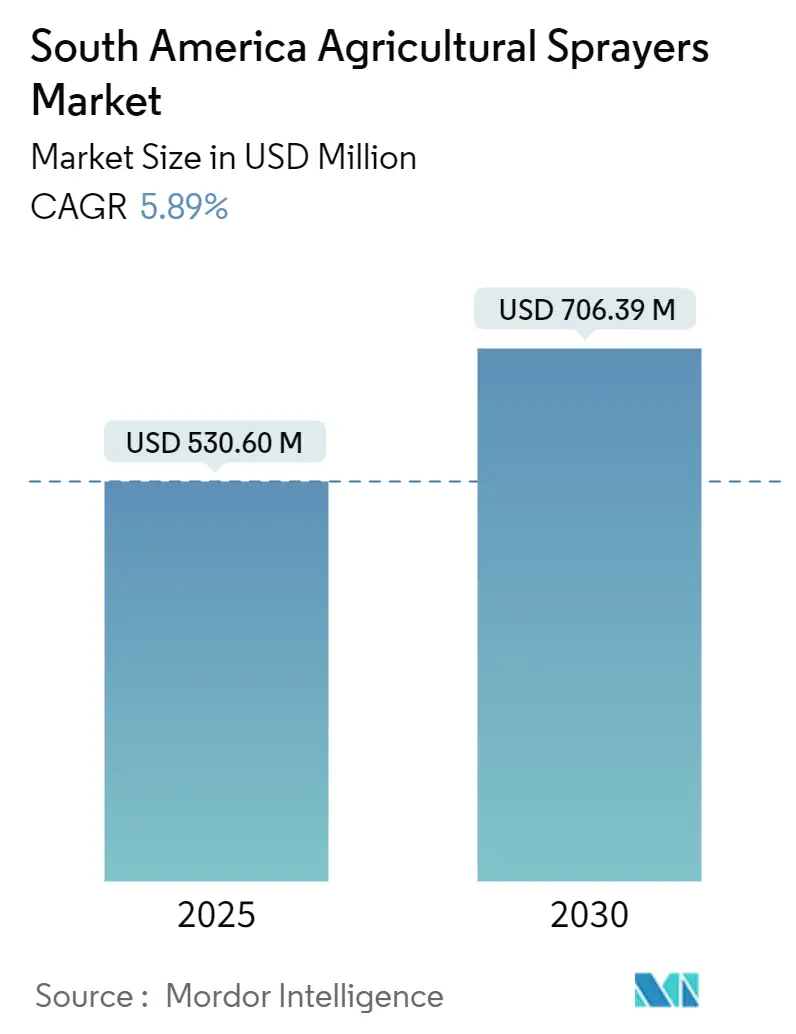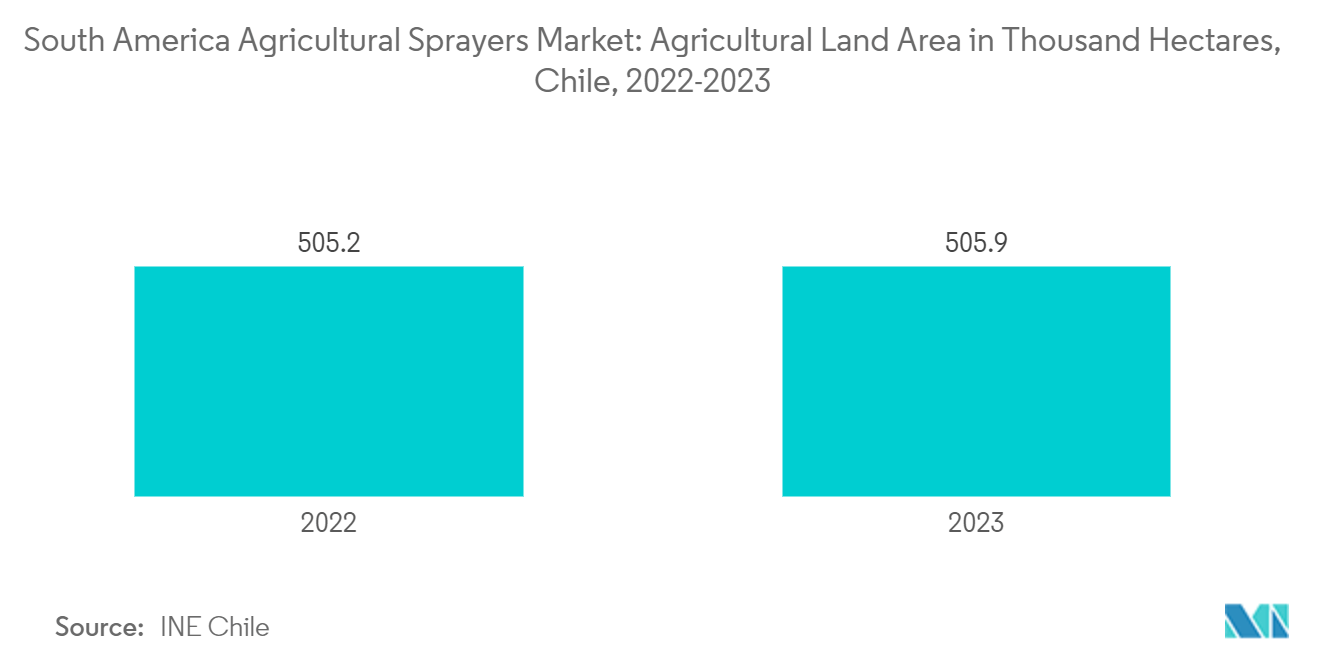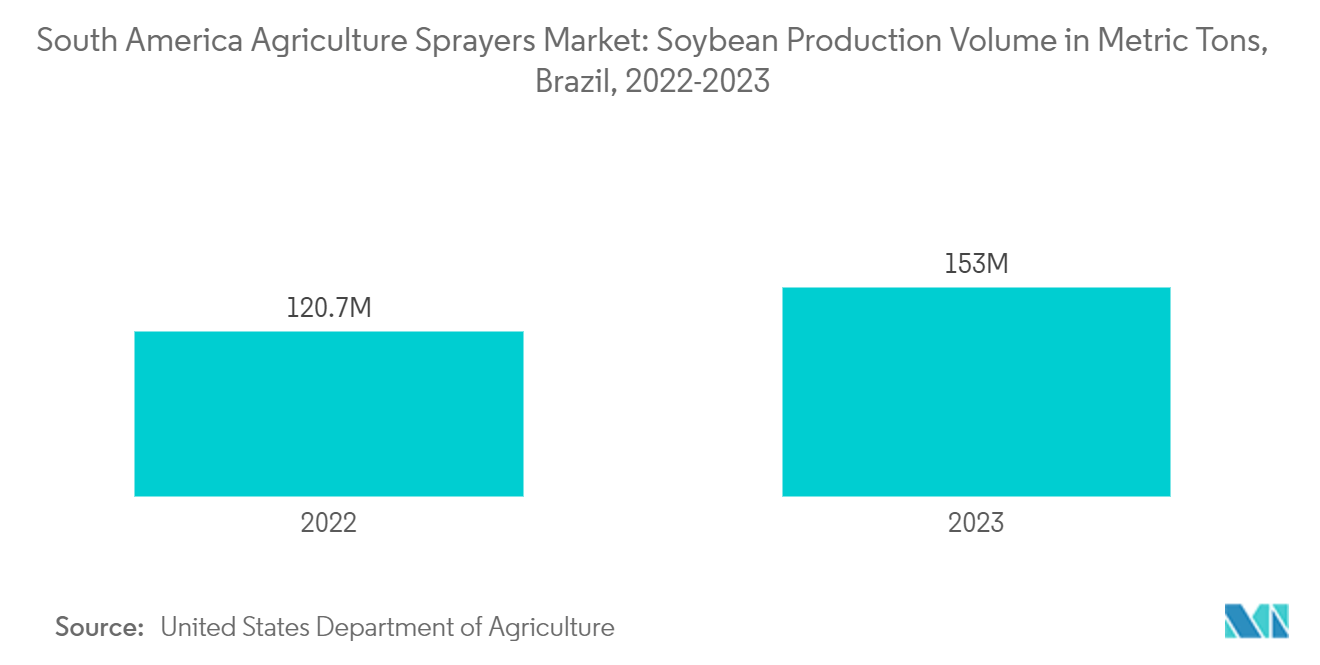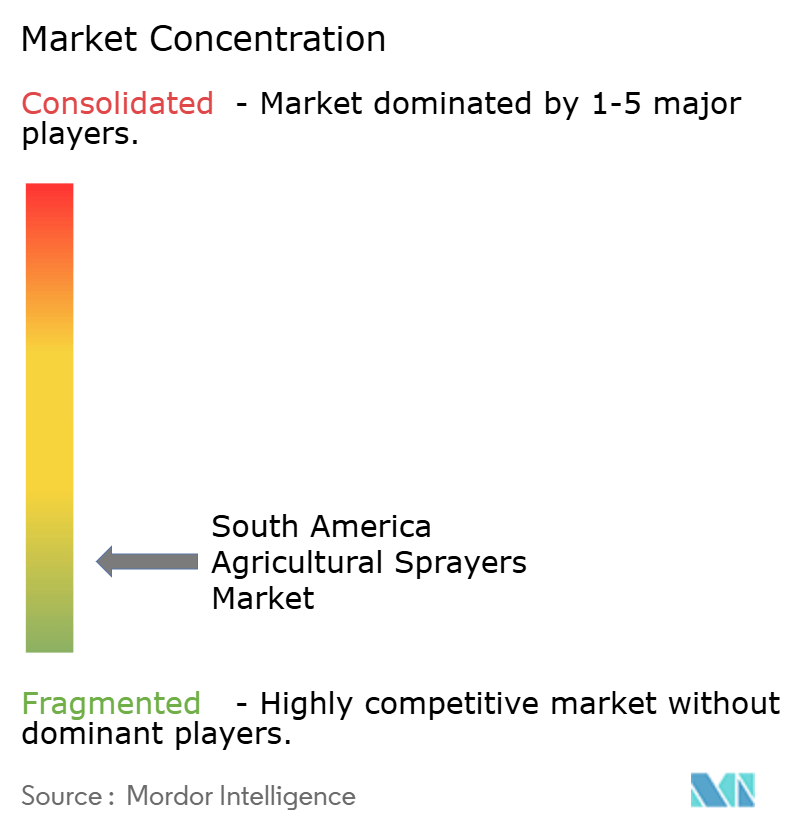South America Agricultural Sprayers Market Analysis
The South America Agricultural Sprayers Market size is estimated at USD 530.60 million in 2025, and is expected to reach USD 706.39 million by 2030, at a CAGR of 5.89% during the forecast period (2025-2030).
Agribusiness is a primary economic driver in South American countries like Brazil and Argentina. The region's diverse climates and vast land areas enable the production of various agricultural products, including soybeans, maize, coffee, and yerba mate. According to the Brazilian Agricultural Research Corporation, Mato Grosso, Brazil's largest agricultural state, saw a 25% increase in planted area in 2023 by converting degraded pastureland into cropland. Soybeans and corn account for over 90% of the crop-planted area in Mato Grosso under the double-cropping system. Furthermore, in the Center-West states, Mato Grosso do Sul and Goias show significantly higher potential for agricultural expansion, reaching 69% and 67% respectively, compared to 2022. This increase in agricultural area contributes to the growth of the agricultural sprayer market.
Plant protection is crucial in crop production, with pesticide application being a key component. Traditional spraying methods have created tension between economic growth and environmental conservation in agriculture. Recent decades have seen continuous advancements in spraying techniques. Robotic and automated technologies, such as variable rate sprayers, UAV sprayers, and electrostatic sprayers, are emerging to enhance pesticide utilization, minimize residues, provide real-time application, reduce costs, and improve the compatibility of plant protection products. These innovations fall under the precision agriculture category. By reducing labor costs and promoting environmental protection, these advanced spraying technologies are anticipated to drive market growth in the coming years.
South American countries have been emphasizing innovative technologies to address labor shortages and water scarcity in the production of their major crops. According to World Map data, the percentage of agricultural labor in Argentina decreased from 7.33% in 2021 to 7.20% in 2022. Farmers increasingly use smart spraying technology that employs multiple sensors and detectors to identify pests and automatically disperse chemicals on crops following preset regulations, ensuring an efficient and sustainable process. The country's industry trend is towards mechanizing agricultural processes and using labor-replacing sprayers, which are in high demand among Argentine farmers.
Major players in the industry are developing advanced sprayers that incorporate AI and IoT technologies. The four-wheeled sprayers are designed to automate the complex, time-intensive, and potentially dangerous task of applying chemicals and other agents to high-value crops in orchards and vineyards. The introduction of these innovative sprayers, tailored to meet the specific needs of South American farmers, is a key factor driving market growth for sprayers during the forecast period.
South America Agricultural Sprayers Market Trends
Growing Farm Sizes Drive Adoption of Agricultural Sprayers
South American agriculture has been characterized by small and medium-sized family farms managing their land and capital. However, in recent decades, countries like Argentina and Brazil have witnessed a trend toward farm consolidation and the emergence of large corporate farming structures. This shift is driving a preference for farm automation equipment to reduce labor costs and improve efficiency. The increasing farm sizes, aimed at enhancing profitability through the use of advanced agricultural sprayers, are anticipated to stimulate market growth in the coming years.
According to INE Chile, the agricultural land area in Chile increased from 505.2 thousand hectares in 2022 to 505.9 thousand hectares in 2023. Similarly, the Brazilian Institute of Geography and Statistics reported that the planted area for agricultural production in Brazil reached 91.1 million hectares in 2022, up from 86.6 million hectares in 2021. This increase in agricultural land area has significantly boosted the adoption of agricultural sprayers. As farms expand, the need for efficient and effective spraying solutions becomes more critical. Larger fields require advanced, high-capacity sprayers to cover extensive areas quickly and uniformly. This expansion drives farmers to seek technologies that maximize productivity, such as modern sprayers equipped with GPS and AI technologies, which ensure precise application of pesticides and fertilizers, reducing waste and improving crop yields. Additionally, the labor savings provided by these advanced sprayers make them an attractive option for large-scale farms facing labor shortages.
Brazil Leads the South America Agricultural Sprayer Market
Brazil's focus on sustainable agrochemical management has driven demand for advanced mechanical sprayers in recent years. The market shows a preference for self-propelled sprayers featuring high-tech capabilities, including automatic section control, data transmission, and direct injection systems. These technologies ensure the precise application of agricultural chemicals. Brazil's vast agricultural areas, particularly in states such as Mato Grosso and Parana, necessitate efficient, high-capacity spraying equipment.
Brazil ranks among the world's top producers of corn and soybeans. The United States Department of Agriculture reports that in 2023, Brazil produced 153.1 million metric tons of soybean and 122.1 million metric tons of corn, compared to 120.7 million metric tons and 109.4 million metric tons respectively in 2022. These crops are predominantly cultivated on large-scale farms, necessitating high-capacity sprayers for efficient coverage of extensive areas and timely application of pesticides and fertilizers. Advanced sprayers, including air-assisted and precision models, provide comprehensive coverage and penetration, particularly in dense crop canopies. As corn and soybean plants mature, their canopies become denser, challenging conventional sprayers to reach all plant parts. Air-assisted sprayers enhance droplet deposition within the canopy, ensuring pesticides and fertilizers reach the lower plant sections. These factors are projected to drive the sprayer market growth in Brazil in the coming years.
Additionally, the Brazilian government has been promoting the adoption of advanced sprayers among farmers to boost crop production. In 2021, Brazil introduced its farm subsidies funding bill, commonly known as the Crop Plan, which primarily focuses on loans for machinery purchases. The government increased the program's total budget by 6.1%, amounting to USD 44.2 billion. Of this, USD 10.6 billion is allocated for subsidized loans for agricultural machinery. These measures are anticipated to motivate Brazilian farmers to invest in advanced farm sprayers to improve crop yields.
South America Agricultural Sprayers Industry Overview
The South America agriculture sprayers market is fragmented with few players holding a major share of the market. Agricultural Machines Jacto SA, CNH Industrial N.V., Stara SA, AGCO Corporation, and Deere & Company are some of the major players who are operating in the region. The South America agriculture sprayers companies are not only competing based on product quality or product promotion but are also focused on other strategic moves, like acquisitions and expansions, to acquire a larger share and expand their acquired market size.
South America Agricultural Sprayers Market Leaders
-
Deere & Company (PLA Group)
-
AGCO Corporation
-
CNH Industrail N.V.
-
Stara SA
-
Agricultural Machines Jacto SA
- *Disclaimer: Major Players sorted in no particular order
South America Agricultural Sprayers Market News
- May 2024: John Deere has commenced production of its See & Spray Select smart spraying technology in an expanded factory in Goias with an investment exceeding USD 120.7 million. This system utilizes computer vision, artificial intelligence, and machine learning to apply herbicides precisely to target areas, reducing overall herbicide usage.
- June 2024: Agricultural Machines Jacto SA, a Brazilian multinational of agricultural machinery introduced the Jacto SB-20B battery-powered backpack sprayer. This ergonomically designed product offers high cost-effectiveness. It features a pump with exceptional durability, lasting five times longer than comparable market offerings. The company also ensures the availability of spare parts for this sprayer.
South America Agricultural Sprayers Industry Segmentation
An agricultural sprayer is a piece of equipment that is used to apply herbicides, pesticides, and fertilizers on crops. The South America agricultural sprayers market is segmented by the Source of Power (Manual, Battery-operated, Solar Sprayers, and Fuel-operated), Usage (Field Sprayers, Orchard Sprayers, and Gardening Sprayers), Mode of Capacity (Ultra Low Volume, Low Volume, and High Volume) and Country (Brazil, Argentina, and Rest of South America). The report offers market size and forecasts in terms of value (USD) for all the above segments.
| Source of Power | Manual |
| Battery-operated | |
| Solar Sprayers | |
| Fuel-operated | |
| Usage | Field Sprayers |
| Orchard Sprayers | |
| Gardening Sprayers | |
| Mode of Capacity | Ultra Low Volume |
| Low Volume | |
| High Volume | |
| Country | Brazil |
| Argentina | |
| Rest of South America |
South America Agricultural Sprayers Market Research FAQs
How big is the South America Agricultural Sprayers Market?
The South America Agricultural Sprayers Market size is expected to reach USD 530.60 million in 2025 and grow at a CAGR of 5.89% to reach USD 706.39 million by 2030.
What is the current South America Agricultural Sprayers Market size?
In 2025, the South America Agricultural Sprayers Market size is expected to reach USD 530.60 million.
Who are the key players in South America Agricultural Sprayers Market?
Deere & Company (PLA Group), AGCO Corporation, CNH Industrail N.V., Stara SA and Agricultural Machines Jacto SA are the major companies operating in the South America Agricultural Sprayers Market.
What years does this South America Agricultural Sprayers Market cover, and what was the market size in 2024?
In 2024, the South America Agricultural Sprayers Market size was estimated at USD 499.35 million. The report covers the South America Agricultural Sprayers Market historical market size for years: 2019, 2020, 2021, 2022, 2023 and 2024. The report also forecasts the South America Agricultural Sprayers Market size for years: 2025, 2026, 2027, 2028, 2029 and 2030.
Our Best Selling Reports
South America Agricultural Sprayers Industry Report
The South America Farm Sprayers Market report provides a comprehensive industry analysis and market forecast for agricultural sprayers in the region. It covers various segments such as the source of power, usage, and capacity mode, offering a detailed market overview and market segmentation. The industry outlook indicates a positive growth rate, with significant market growth driven by advancements in technology and increased adoption of efficient farming practices. The report includes market data and industry statistics, highlighting key market leaders and their contributions to the market value.
The market report also delves into market trends and industry trends, providing insights into the latest developments and future market predictions. The industry research and market research conducted in this report are thorough, ensuring that all relevant market information is covered. The report example and report PDF are available for further reference, offering a detailed market review and industry reports.
Furthermore, the market analysis includes a historical overview and market forecast, projecting the market's trajectory. The industry sales and market size are examined, along with market share and market segmentation. The report also explores the role of research companies in shaping the market outlook and industry outlook. Overall, this report is a valuable resource for understanding the South America Farm Sprayers Market, its market trends, and industry statistics.

